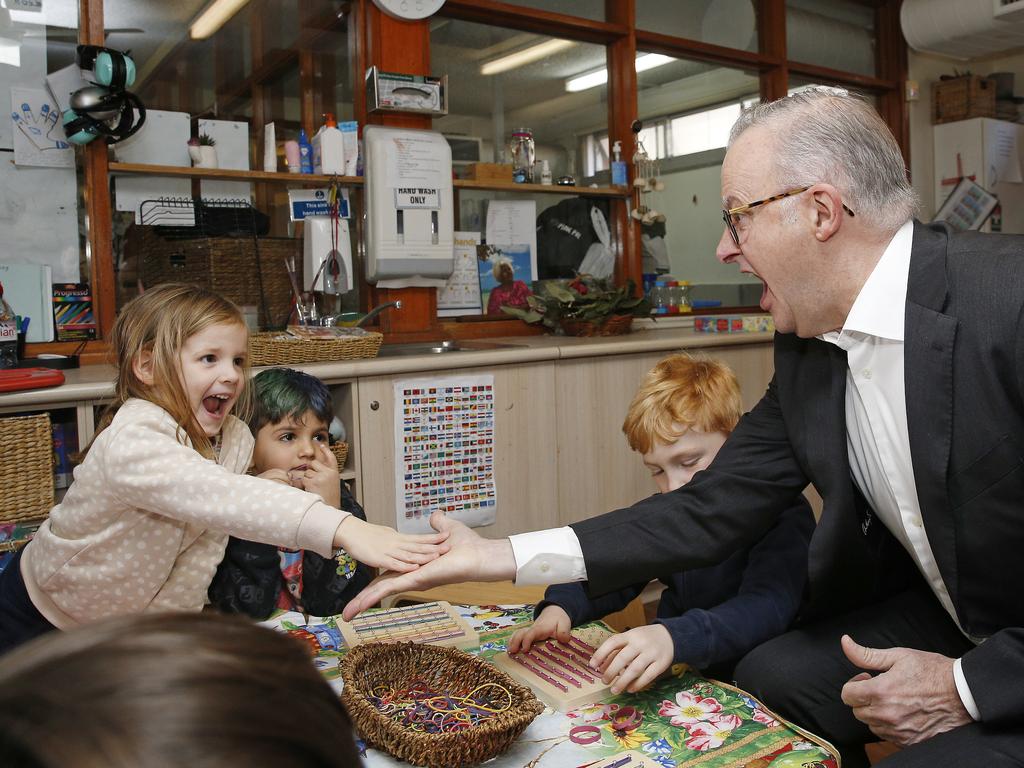Universal child care would only end up on Labor’s spending pyre


My strong advice to the Prime Minister is: don’t do it. It is ill-considered, badly targeted and unaffordable. And the biggest winners will be high-income earners who currently receive proportionately lower childcare fee subsidies than those on lower incomes.
It’s hard to see how that aspect will be a vote winner. The backdrop to this is the commissioning of a report, A path to universal early childhood education and care, from the Productivity Commission. A draft was released last year; the final report has now been sent to the government and is awaiting release.
One of the key findings of the draft report was that the U-shape that once characterised women’s workforce participation – there was always a dip during women’s early child-rearing years – has almost disappeared. To be sure, only a small proportion of children under the age of one attend childcare. But after that, the proportion rises significantly.
We can’t infer that this outcome is simply the result of the preferences of career-minded women. Rather the financial needs of most families to have two sources of income means a great many parents have no choice but to use childcare, particularly as cost-of-living pressures have escalated. This distinction needs to be borne in mind when thinking about policy options.
Another important distinction is between childcare and preschool. There are currently in place governmental agreements that guarantee 15 hours per week of structured preschool for three- and four-year olds. In many instances, these preschool programs are delivered by childcare centres, but there are still many dedicated preschools – around 4300 in 2022.
The developmental and educational benefits of childcare and preschool are not the same. Preschool does what it says – prepares little ones for school. The idea that there are developmental and educational benefits for one-year olds in childcare is much more fanciful.
The world’s leading academic in this area, James Heckman, has made the obvious point that the only real developmental and educational benefits for children attending childcare are for those who come from disadvantaged backgrounds. Chaotic family environments, inadequate income, an absence of consistent nutrition, a lack of books and being read to – these are contextual features of children who benefit from childcare.
For other children, however, there is no beneficial effect on average. Indeed, they can be worse off because they are deprived of the constant attention of at least one parent, which would greatly benefit them. When Albanese claimed there are educational benefits from childcare because he observed some children playing with lettered blocks, he was merely demonstrating his ignorance in this field.
But here’s a key point: the participation of children from disadvantaged backgrounds in childcare is low compared with other children. Out of every 100 children who take up a subsidised early childhood education and care place, only 23 are from low-income families. As the Productivity Commission notes, “early childhood education and care is positive for many children but those who benefit most are least likely to attend”.

The under-representation of children from disadvantaged backgrounds is the result of a number of factors, including the relative dearth of childcare centres in poorer areas as well as the activity test, which many parents fail to meet.
The reality is that the benefits of government-subsidised childcare are largely snaffled by the middle class. Note here that this government extended eligibility for childcare fee relief to those families earning up to $533,000 per year, although the rate of fee subsidy is scaled down as income rises.
Another interesting fact about childcare is the dominance of private, for-profit centres, a dominance that has increased over time as community-managed centres have either closed or failed to grow. Family daycare is a relatively small part of the mix, at less than 6 per cent of childcare places.
What this means is that government childcare subsidies are mainly directed towards private businesses, which must meet capital and labour costs as well as deliver a return to shareholders. This is a very different beast to government funding of public schools.
In its draft report, the PC recommended that 30 hours or three days per week of quality early childhood education and care should be made available to all children aged between up to five years.
The PC also modelled the effects of a 90 per cent subsidy applied across the board save for those families with income less than $80,000 for whom there would be no fee charged. The estimated cost of this exercise is more than $4bn per year or around one-third on top of current outlays. But the main beneficiaries “would be higher-income families, as many low-income families receive subsidies at 90 per cent or higher rates”. In other words, this feature of the policy should give the Labor government reason to hit the pause button.
No doubt, government ministers will point to the supposed broader economic benefits of further subsidising childcare, particularly greater workforce participation. The modelling is clear that any impact on participation will be modest, perhaps as low as an additional 17,000 effective full-time workers. There are a variety of reasons for this outcome, including the shift towards centre-based care away from other forms of care, as well as the fact cheaper childcare means parents can work fewer hours and achieve the same net income.
The cost of providing three full days of universal care works out at more than $200,000 per job created. This is a very poor use of taxpayer dollars. As for any impact on productivity, it would almost certainly be negative as the most productive workers are already working long hours.
In the meantime, the government has committed to spending even more taxpayer dollars topping up the wages of childcare workers in line with a potential ruling from the Fair Work Commission. The cost of this exercise is put at $3.6bn over two years and, in exchange, centres must agree to enter into union wage agreements as well as keep fee increases to 4.4 per cent for one year. Topping up wages is likely to become a permanent commitment.
The bottom line is that childcare is yet another area in which government spending is out of control. In 2018-19, childcare subsidies cost less than $8bn; this financial year, they are expected to come in at $14.5bn, before adding in the wage subsidy package.
There are very serious questions about both the effectiveness and fairness of the policy settings, both current and proposed. For private providers, however, it’s a lucrative industry.







Anthony Albanese has foreshadowed on a number of occasions that universal childcare will be a centrepiece of his campaign for a second term in office. His stated intention is that universal childcare will become available midway through that term.